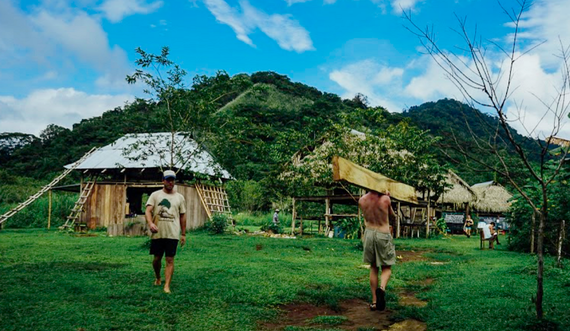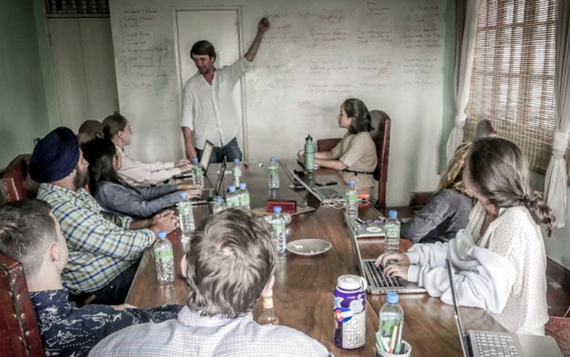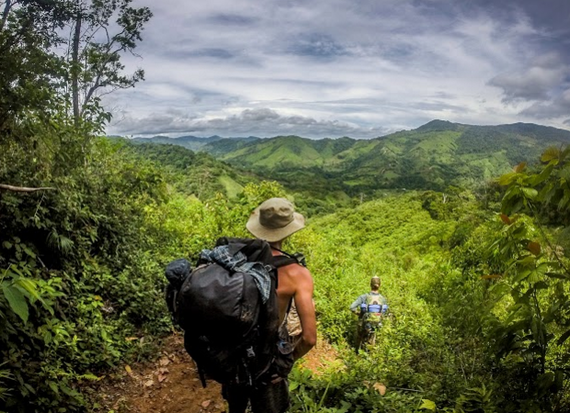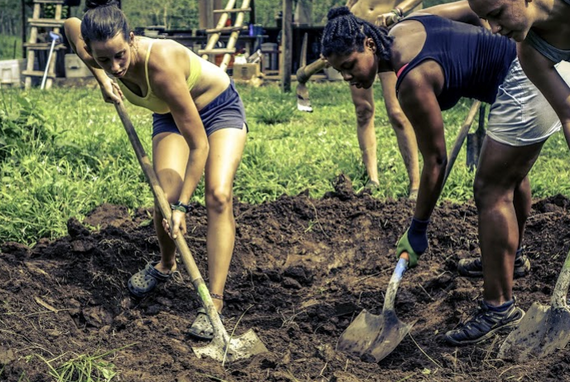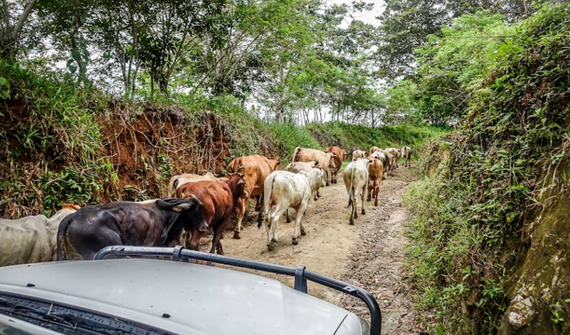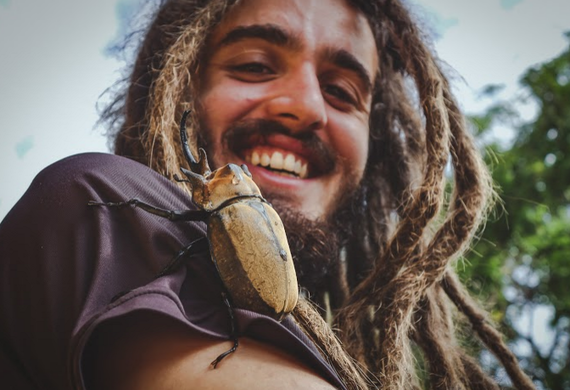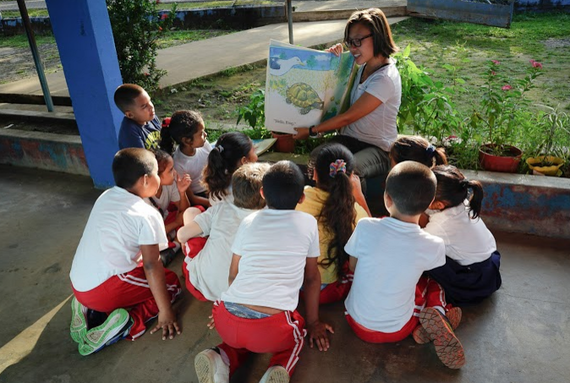It's 10 am on a Tuesday in the Tres Brazos jungle, a jagged two-hour trek outside Panama City, where a handful of American twentysomethings have been awake and working since sunrise.
Aaron Prairie leads a group of biology students on a nature hike, using a machete to hack his way through an overgrown trail. Max Cooper cuts long strips of plywood with an electric saw powered by a solar generator, the beginnings of an open-air thatch hut he'll eventually build by hand.
Jake Cardoza is on his hands and knees in the adjacent permaculture farm, planting a baby banana tree. A few yards away in the kitchen, also fashioned as an open-air thatch hut, Brigitte Desvaux chops onions. Later, she'll saute them for dinner along with with fresh katuk, a tropical green with a nutty taste, harvested from the farm that morning.
Three miles up the steep dirt path that leads out of the jungle and into the 500-person community of San Miguel, Jennifer Theone teaches English to first graders at the local school. At the dental clinic down the road, Dixie Hendley and her public health students help the staff sterilize tools and organize their supplies for the day.
Over in Panama City, Kristy Strait puts the finishing touches on a promo flyer for an upcoming New Year's event, a 150-person, 4-day mix of outdoor activities, speaking engagements and live music that will be hosted in Tres Brazos. Jimmy Stice, the Atlanta-born marketing whiz responsible for the flurry of aforementioned activity, paces in circles around her. His hair flops to one side as he talks breathlessly with his hands, skipping around from topic to topic as quickly as he moves, a whirling dervish of ideas and action plans.
He's considering a farming partnership with a local billionaire. He's pinning down transportation logistics for his 30 New Year's volunteers. He's preparing talking points for an interview with a Peruvian newspaper, happening in 20 minutes. He's mulling the effectiveness of Facebook ads versus targeted networks. He's captivated by a recent book he read about Henry IV's 17th-century concept for Paris as a walkable city and angry that today's understanding of capitalism has been "willfully distorted." He's wondering what time he should be in San Miguel on Thursday, where a few dozen college students will present their visions for the future of his organization.
Stice's organization is Kalu Yala, a research institute and sustainable community currently comprised of a study abroad program, an organic farm-to-table operation and an events business. He has 20 full time staff members, most of whom live communally in either Tres Brazos or San Miguel. But he's dreaming much bigger: Stice's ultimate plan is to build what he describes as the world's most sustainable modern town, a thriving eco-society in the middle of the jungle where residents and visitors alike can live in harmony with their natural surroundings.
"I'm creating a model for how to build a civilization that supports both the earth and its people," Stice, 33, says. "In order to address social problems, you first have to look at environmental ones."
A GRAND VISION
In Stice's dream version of Kalu Yala, sustainable homes and infrastructure occupy roughly 20 percent of the land. The structures are connected by porous paths lined with trees that form a natural canopy, preventing excess heat from the sun. Thirty percent of the property is restored to a well-maintained food forest and permaculture farm, which both increases the area's biodiversity and feeds the community. The remaining half, much of which borders the Chagres National Park, is conserved.
"I want what we consume to actually improve upon the natural world," he explains, adding that Kalu Yala means "sacred land" in Kuna, the language of Panama's largest indigenous group. "We don't just want to have as little impact as possible, but actually make the region better by occupying it."
Stice, who counts Jane Jacobs and "The Sandlot" among his greatest inspirations, describes his approach for building and growing Kalu Yala as four-pronged: education, hospitality, entrepreneurship and real estate.
The research institute, which emphasizes hands-on education, has already been up and running for a few years. It includes curriculums in design thinking, business, outdoor recreation, agriculture, biology, culinary arts, public health and education, and draws up to 80 college-aged students each semester.
For a tuition fee of 5 grand, students live in either San Miguel or the jungle for 10 weeks, where they sleep in hammocks and eat three meals a day cooked by Desvaux, Kalu Yala's farm-to-table director. They spend as much time wielding machetes and examining insects in the forest as they do reading textbooks and discussing permaculture philosophy in the thatch huts.
Deign to suggest Stice is creating a collective fit for a flower child, though, and he'll respond jokingly-yet-firmly that "we hate hippies." He's got no qualms about wanting to make money, and he hopes Kalu Yala's hospitality, entrepreneurship and real estate initiatives will do just that.
The tourism business, set to formally kick off next month, will host both small groups of travelers and large-scale events, like TEDx conferences and the upcoming New Year's extravaganza. Visitors will pay an all-inclusive fee, which includes a luxury campsite designed by a former Kalu Yala student and access to hiking trails, yoga, horseback riding and the farm-to-table restaurant.
His business incubator, launching next year, will allow former students and entrepreneurs to work on their startups on-site with the help of funding from Kalu Yala's investors and mentors from their network. Meanwhile, the U.S.-based architecture firm Studio Sky, known for their eco-friendly designs, has prototyped a series of 2-bedroom homes constructed from reclaimed wood and other native Panamanian materials. Construction on the first house begins next year, and Stice hopes to sell them for $200,000 a pop to a mix of expats and locals.
The company isn't profitable yet, and all the money the research institute brings in is immediately reinvested in the education piece. But Kalu Yala's private investors, who have poured $3.8 million into the whole shebang since Stice began raising money in 2008, stand to benefit handsomely should the real estate, entrepreneurship and hospitality ventures succeed.
Stice's vision, however, extends far beyond even those four pillars. He's laying the groundwork for a jungle recording studio and maker's space in an effort to draw musicians and artists from all over the world. He's in the early stages of turning his farm into a large-scale producer co-op and specialty foods business that would provide job opportunities for other local farmers. Google's current designer-in-residence, Elysa Fenenbock, is helping him design a K-12 school, which would serve both Kalu Yala and the surrounding Panamanian communities, like San Miguel.
"We won't be a town until we have a school," Stice says. He wants the school to open in as little as five years, and says tuition from more affluent families will offset the costs for local students.
"Once I realized we would be able to create economic opportunities in the area," he adds, "I wanted to create a place where the people already growing up here can be adequately trained to fully take advantage of those opportunities."
WELCOME TO THE JUNGLE
Stice's grand plan may sound idealistic -- perhaps even pie-in-the-sky and a little ridiculous. Yet he's already come a long way from when he purchased the Tres Brazos property with his father seven years ago. Back then, it was little more than 600 acres of abandoned cattle pasture, a sharp contrast from today's lush food forest and vibrant, growing community of visitors, students and permanent residents.
Cooper, 27, Stice's de facto right hand man, oversees the education institute. He's been living in the jungle since attending one of Kalu Yala's earliest study abroad semesters, in 2011. During his first year, everyone slept in tents, peed in the grass, and collected their water in 5-gallon drums from a tributary nearly a mile hike away.
"We cooked on camp stoves and lived in absolute squalor," Cooper recalls. "Everyone had jungle rot on their feet. Our clothes were destroyed by the rain."
With the help of their neighbors, septuagenarian brothers Ramon and Dario Jaen, who have lived in Tres Brazos their entire lives, Cooper and the other early inhabitants learned how to properly wield a machete and construct open-air "ranchos" with palm-leaf roofing to keep out the rain. They built a kitchen and composting toilets and a piping system that brings filtered running water to showers and sinks directly from the tributary.
In addition to hauling and hammering and building up the physical infrastructure, students and staffers are constantly conducting research and outlining plans for future Kalu Yala programs. The idea for the specialty foods brand, for example, came from a former business student's final project. So did the original blueprints for the tourism and hospitality venture. This semester, biology students are working on proposals that would introduce mushroom cultivation and pig farming to the jungle, and a design student is GPS-mapping the entire site.
Given the organization's startup vibe and rustic, communal accommodations, it's certainly not for everyone. Scrappiness, resilience and comfort with the unknown are all required qualities in order to stay sane. Some students leave unhappy, confused by the company's mission, chewed up and spit out by the jungle's unforgiving landscape.
Those who thrive are self-starters, brimming with ideas and the patience for actualizing them slowly, who learn by trying and failing and then trying again. And like Cooper, many of Kalu Yala's current employees were once students themselves, high performers later rewarded with leadership roles.
Prairie, 24, Kalu Yala's biology director, graduated from the same program. On a recent nature hike, he became the first scientist in the world to discover a rare breed of coral snake living in Panama. The journal Mesoamerican Herpatology published his report on his findings. Meg Pelham, 26, also a biology graduate, has since served as outdoor recreation director, biology director, business director and CFO. Next year, she'll be in charge of tourism and hospitality.
Desvaux, 27, Kalu Yala's farm-to-table director and an outdoor recreation graduate, never went to culinary school. She constantly invents new recipes with the farm's ingredients -- plantain lasagna, cranberry hibiscus tea -- through trial and error. Cardoza, 24, the farm manager, graduated from the agriculture program. He taught himself organic farming techniques by reading books like The New Organic Grower cover to cover and learned which plants thrive in a tropical food forest by watching instructional YouTube videos.
"Living here gives you the opportunity to constantly learn, every day," Cardoza says. "Not just through your job, but a ton of different things. Plumbing because we have to fix a pipe. Carpentry. Cooking. It's meaningful because I can see the results of my job physically -- the people around me literally eat them."
FRIENDLY NEIGHBORS
Skeptics often ask Stice what a bunch of idealistic gringo millennials living together in the jungle are doing doing to responsibly integrate with the wider Panamanian community. But observing Kalu Yalans interacting with their neighbors suggests it's extremely important to them.
The Jaen brothers often visit when they're not working; on a recent Sunday evening they came over to eat burgers and watch a football game streamed from Cooper's laptop using solar-powered wifi. Cooper knows every family along the route from the jungle property to San Miguel, and he'll stop by to ask how their kids are doing or drop off supplies.
Kalu Yala's San Miguel outpost, where the education and health programs are based in a sprawling yellow house with a big front porch, perhaps affords the most opportunity for fostering relationships with locals. In addition to teaching at the school and helping out in the clinics, the students and staff attend meetings at the library and senior center, cook weekly dinners for their neighbors and simply spend hours hanging out, chatting, learning about their lives.
"The real relationships happen after work, sitting on people's porches, having a meal, having a conversation. A lot of what we do is listen," Hendley, 38, the health and wellness director, says as she stops to greet a dairy farmer crossing the road with her calves. "Most NGOs go into places with this set idea of what people need. We want to join in with what this community is already doing; to build relationships and learn about their strengths before bringing our own ideas to the table. That doesn't just come from knowing people's names -- it comes from months of getting to know them."
Henley's philosophy of community engagement comes to life as 12-year-old Franco Ramos sits on the porch at the San Miguel house, entertaining some of Kalu Yala's students with his catalogue of funny voices.
"I come here almost every day after school," Ramos, who lives around the corner, says in Spanish. "I love these guys. I want to study biology with them one day."
"When he's here he's just a straight goofball," Theone, the education director, interjects.
"Well, it's really boring in my house," Ramos replies. "I like it here. Somos friends."
Back in his Panama City apartment, where he'll live until the first sustainable jungle home is built, Stice says he shrugs off people who accuse him of being a colonizer of sorts. "The reality is that the world is global," he says. "The real question is, how does any new neighbor in any neighborhood best contribute to the place they just moved to?"
Assimilation aside, Stice fields one other, very specific critique about Kalu Yala from nearly everyone he meets: They want to know if he's really just running a cult. And he absolutely loves answering that question.
"One of my online bios says I'm a cult leader because I think that whole line of conversation is really funny," he says with his signature grin. "But cults drink Kool-aid, and I don't want to die. We're having way too much fun."
Photos by John DuPre. Learn more about Kalu Yala here.
Disclosure: While the author of this post was not employed by Kalu Yala at publication time, she has since taken a job as the organization's media director.

